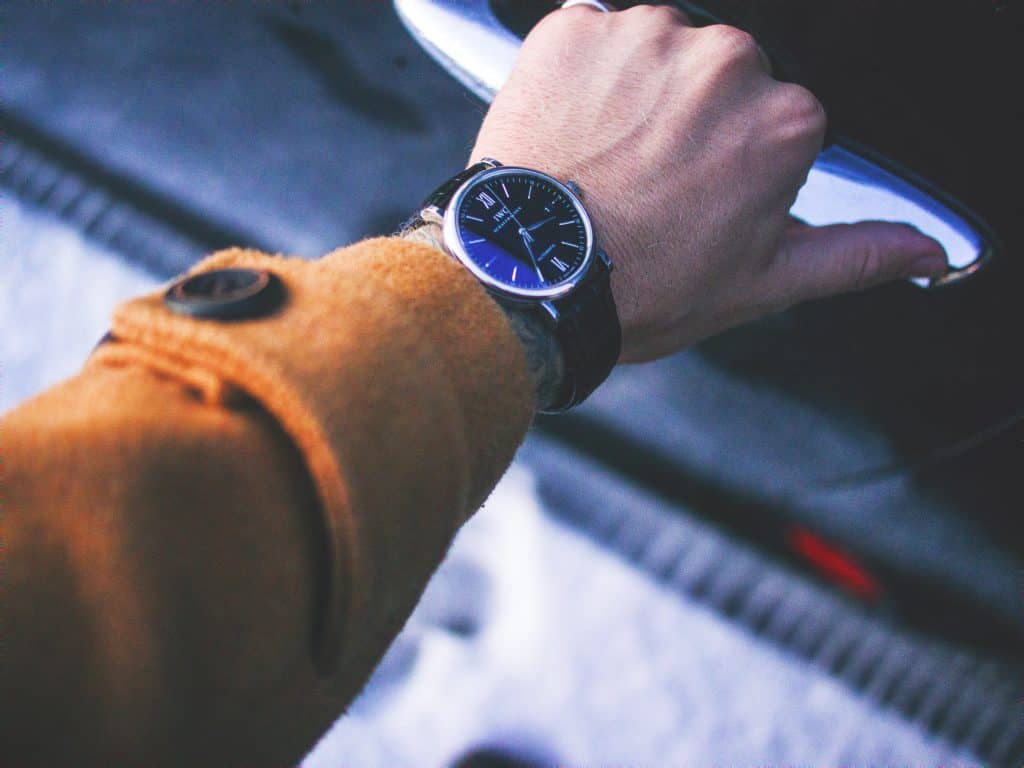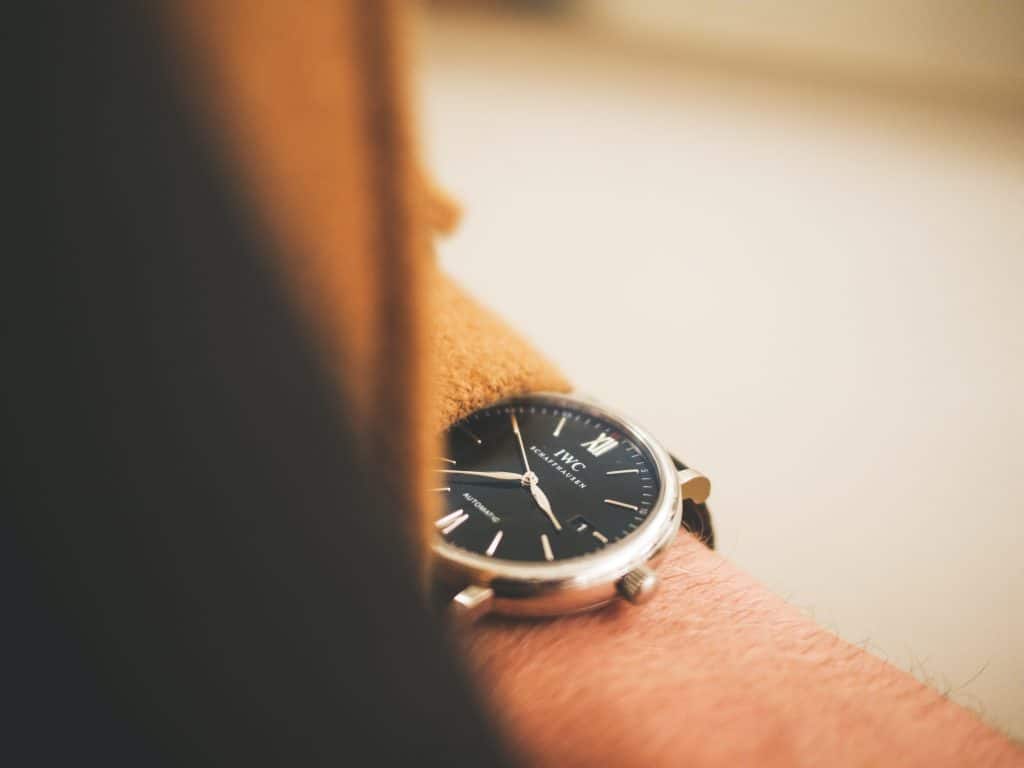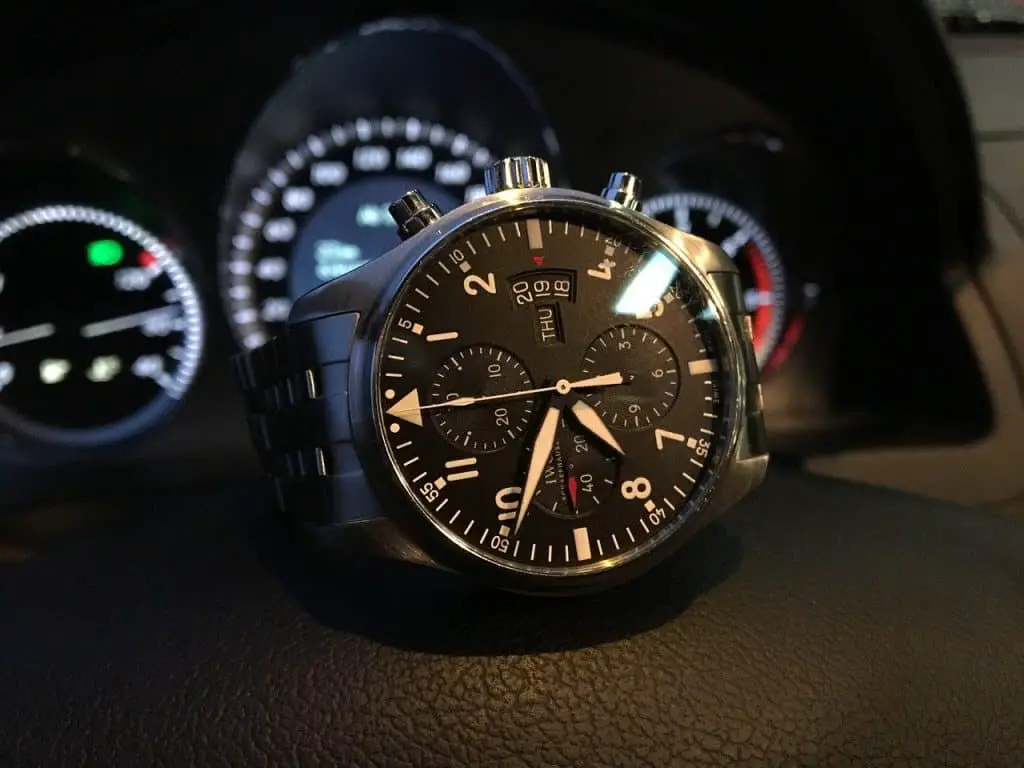Like many other watch brands, IWC watches have unique serial numbers. However, it can be difficult to decode them and understand what they mean and how they’re structured. So, what do IWC watch serial numbers mean?
IWC watch serial numbers indicate the year that each watch was made. They also help confirm the authenticity of each watch. There are public serial number lists that you can use to find out what year your vintage IWC watch was made. Most serial numbers are engraved on the watch movement.
The rest of this article will discuss the meaning of IWC watch serial numbers in greater detail. It will also discuss what they should look like, how to read them, and if you can tell where a watch was made by examining the serial number.

Table of Contents
IWC Watch Serial Number Meaning
An IWC watch serial number allows you to understand more about your watch as it indicates how old it is (if it was made pre-1976). It also helps keep track of the history of your watch (for example, the repair or purchasing history). However, only IWC watch professionals can gather this data from a serial number.
The serial number also tells you that your watch is legit. If you have concerns about the authenticity of your watch, you can have a professional examine the serial number.
Since IWC watches are expensive and highly luxurious, each watch must have a unique serial number because it makes each one unique and proves that it’s the real deal. It’s why all high-end watches have serial numbers, including Tissot and Breitling.
What an IWC Serial Number Should Look Like
Although all IWC watches have serial numbers, they can contain a varying number of digits. An important thing to know is that every serial number contains numbers only–there are no letters or other characters in an IWC serial number.
You’ll most likely find the serial number on the movement of your watch. However, it will be on the case back on specific models. To locate yours, you should first look at the case back. Sometimes, the serial number may appear on the outside. If that’s the case, you won’t need to take the watch apart.
But if you can’t see the serial number on the case back, you’ll need to open the watch to view it.
Once you find it, you should be looking at a number with many digits. IWC watches contain serial numbers anywhere from one to seven digits long (if the watches were made pre-1976). Suppose your watch was made after this period. In that case, it’s more challenging to figure out the manufacture date by reading the number because there are no public serial number lists available for watches older than this.
Below are some examples of vintage IWC watch serial numbers and their corresponding (approximate) years of manufacture:
- Serial numbers 28,251 – 49,300: Years 1890-1895
- Serial numbers 117,301 – 211,200: Years 1895-1900
- Serial numbers 211,201 – 321,300: Years: 1900-1905
- Serial numbers 321,301 – 463,600: Years 1905-1910
- Serial numbers 463,601 – 620,800: Years 1910-1915
- Serial numbers 620,801 – 742,300: Years 1915-1920
- Serial numbers 742,301 – 807,400: Years 1920-1925
- Serial numbers 807,401 – 919,600: Years 1925-1930
- Serial numbers 919,601 – 940,000: Years 1930-1935
- Serial numbers 940,001 – 1,013,200: Years 1935-1940
- Serial numbers 1,013,201 – 1,092,400: Years 1940-1945
- Serial numbers 1,092,401 – 1,200,400: Years 1945-1950
- Serial numbers 1,200,401 – 1,335,400: Years 1950-1955
- Serial numbers 1,335,401 – 1,513,000: Years 1955-1960
- Serial numbers 1,513,001 – 1,778,800: Years 1960-1965
- Serial numbers 1,778,801 – 1,970,200: Years: 1965-1970
- Serial numbers 1,970,201 – 2,265,400: Years 1970-1975
How To Read IWC Watch Serial Numbers
To read an IWC watch serial number, you must first examine the digits. If it was made pre-1976, the number of digits will help you determine how old your watch is. For example, if the serial number on your vintage IWC watch has six digits, it indicates that it was made before the 1940s.

To get an even better idea of how old it is, you can examine each digit and compare them to an IWC serial number list, like the one I have above.
Unfortunately, there’s no known way to determine when a newer IWC watch was made by reading the serial number. However, you could contact IWC directly to see if they can give you more information on your watch.
Do IWC Watches Have Model Reference Numbers?
IWC watches have model reference numbers, but only the serial numbers are on the watches. Each model has a specific model reference number, which isn’t always unique to each watch. For example, all Big Pilot’s Watch 43’s have IW329301 as a model reference number.
The model reference number indicates the model of the watch. Unlike the serial number, it doesn’t determine the year the watch was made. If you’re unsure what model your watch is, you can bring it to an IWC boutique to have it checked. They may be able to give you the model reference number of the watch if you don’t know it.
If you purchase a watch on the IWC website, you will see the model reference number in the description.
Of course, the model reference numbers can give you a vague idea of when the watch was made. Watch models get discontinued all the time, so you can check your model reference numbers against the years that that specific model was in production.
Can You Tell Where an IWC Watch Was Made?
You can tell where an IWC watch was made because all watches are made in Switzerland. The serial or model numbers don’t tell you where a watch was made. According to IWC’s philosophy page on their website, most watches are made in the French-speaking part of Switzerland.
Since most of their watches are manufactured in Switzerland, you will surely get a carefully crafted Swiss watch.
Although most watches are manufactured in the French-speaking part of the country, some aren’t. Unfortunately, there’s no way to tell where precisely your watch was manufactured just by reading the serial number. If you want to know more about where it was made, you could ask an IWC professional to examine the serial number.
Although you won’t be able to tell precisely where in Switzerland it was manufactured, they might be able to gain more information by inputting your serial number into a computer.
Do All IWC Watches Have Serial Numbers?
All IWC watches have serial numbers if they’re authentic. If an IWC watch doesn’t have a serial number, it’s most likely fake. However, some fakes may have serial numbers, so you should have the number verified if you’re concerned.
Some fake watch manufacturers might use a random number to make the watch look real. Others might copy an authentic serial number, making it more challenging to determine whether the watch is genuine or not.
If that’s the case, other signs usually indicate the watch is fake, which I’ll discuss in the next section.

Signs an IWC Watch Is Fake
As I’ve already mentioned, one indicator of a fake IWC watch is a fake serial number or no serial number at all. So if you’re worried that your watch might be inauthentic, one thing you should check is the serial number. However, there are other indicators of a fake IWC watch.
Below, I’ll discuss some of the main ones:
Scratches on the Glass
It’s important to understand that all IWC watches are made of sapphire crystal. Since the sapphire crystal is high quality and scratch-resistant, there should be no scratches or damage on the glass part of the watch.
Be sure to examine the glass covering closely. If you can see scratches, the watch is probably fake.
Different-Sized Numbers
Most IWC watches have numbers indicating the time of day, and they should all match perfectly. If you notice inconsistencies in the sizes of the numbers or the colors of the numbers, the watch is fake.
You should also make sure all the numbers are appropriately spaced. If there are inconsistencies in the spacing between numbers, it’s another indication your watch is inauthentic.
Overall Cheap Feel
This one is more general, but sometimes it’s easy to tell if a watch is fake just by feeling and holding it. All IWC watches are luxurious and made of extremely high-quality materials, so they should naturally feel slightly heavy.
A fake watch will be made with cheaper materials, so it will be lighter when you hold it. It will have an overall ‘cheap’ feel to it.
Thin, Inconsistent Fonts
Something else to pay attention to is the font of the numbers and letters around the watch. Many places have numbers and letters on IWC watches, including:
- The inside of the case back. Here, you might find the serial number and some branded writing.
- The face of the watch. Here, you can find numbers (including the date on some watches) and writing that showcases the brand.
- The watch movement. In many cases, the serial number is on the watch movement.
It would be best to examine the fonts in all these watch parts. If the numbers or letters don’t always match or appear thinner than they do on genuine IWC watches, there’s a big chance your one is fake. Or, some letters and numbers might be thinner than others.
Where To Get an IWC Watch Serial Number Checked
You can get an IWC watch serial number checked at a verified IWC boutique in your area. They can check when the watch was made and do repairs and maintenance on the watch if needed. If you do this, a professional will be able to verify the authenticity of your watch.
You can also get a certificate of authenticity if you send your watch to Schaffhausen (and if they deem it authentic). They can verify the authenticity by checking the serial number and examining the watch parts.
Conclusion
IWC serial numbers can help indicate when a watch was made, especially if it’s a vintage watch (pre-1976). They can have various digits and are usually found on the watch movement or case back.
If your watch was made before 1976, you can determine the year by comparing the serial number with a published serial number list. If it was made after 1976, you’d need to have the serial number checked by an IWC watch seller.
